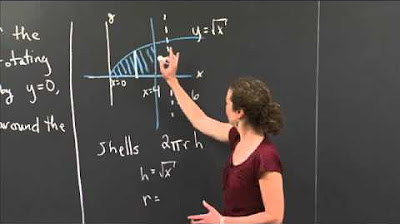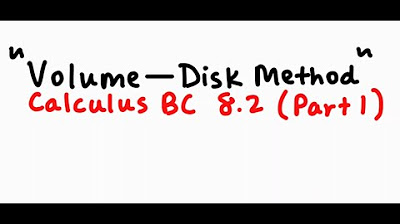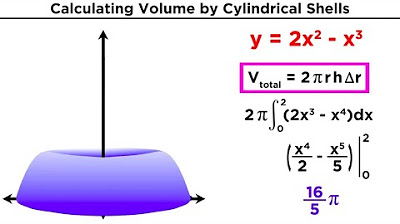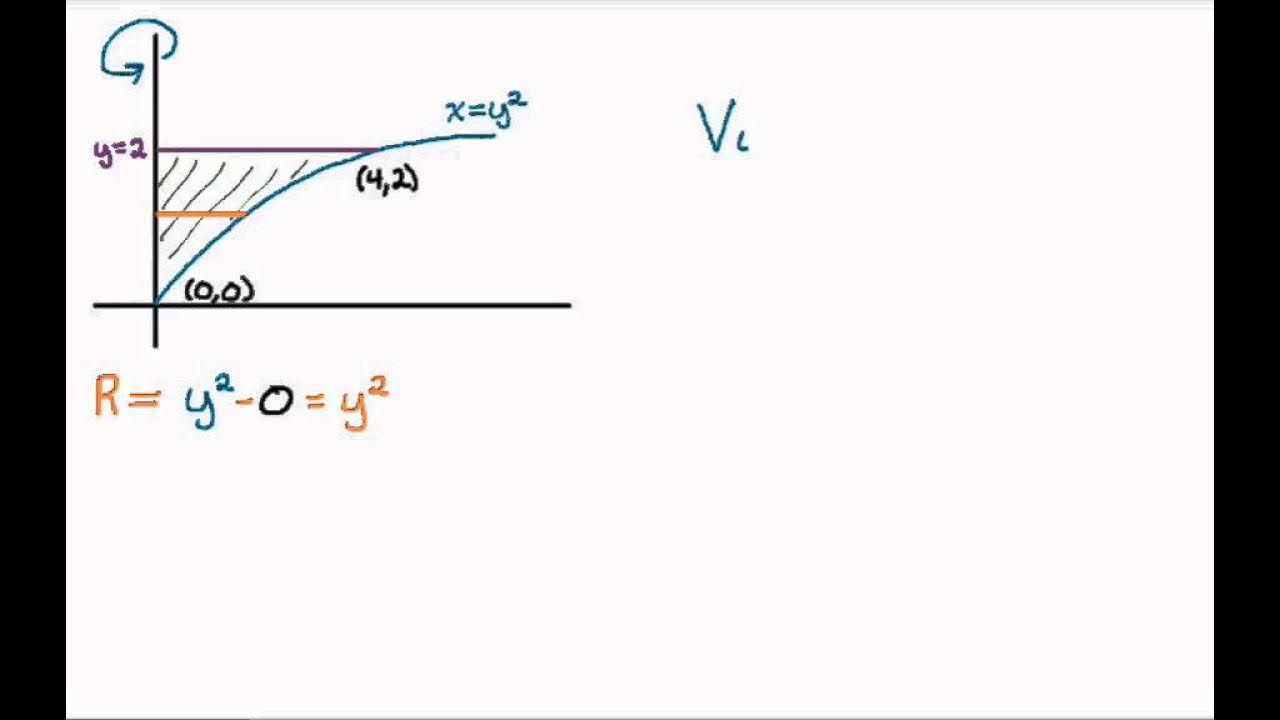Shell Method - Volume of Revolution
TLDRThis video script offers a comprehensive guide on calculating the volume of a solid by rotating a region around an axis using the shell method. It explains the process of drawing rectangles parallel to the axis of rotation and determining the radius and height based on the function's limits. The script walks through examples of rotating regions around the y-axis and x-axis, providing step-by-step instructions on setting up and solving the integrals. The examples include integrals of functions like the square root of x and polynomials, culminating in the calculation of the solid's volume using the formulas 2π times the integral from the limits of the radius and height functions.
Takeaways
- 📈 The shell method is used to find the volume of a solid by rotating a region around an axis.
- 📐 When rotating about the y-axis, the radius is in terms of x and the height is the function value.
- 📐 For rotation about the x-axis, the radius is the function value and the height is in terms of x.
- 🌀 If there are two curves, the height (h) of the shell is the difference between the top function (f(x)) and the bottom function (g(x)).
- 🖼️ Always draw the rectangle (shell) parallel to the axis of rotation for accurate volume calculation.
- 🦘 The limits of integration represent x values for rotation about the y-axis and y values for rotation about the x-axis.
- 🛠️ For the first example, the volume of the solid formed by rotating the region bounded by y=√x, y=0, and x=4 around the y-axis is 128π/5.
- 🔢 For the second example, the volume of the solid formed by rotating the region bounded by y=x-x^3, y=0, and x=1 around the y-axis is 4π/15.
- 🧩 The process involves setting up an integral with the radius and height functions, and then evaluating the integral over the given limits.
- 📚 Practice is encouraged by pausing the video and attempting the problems before revealing the solutions.
Q & A
What is the shell method used for finding volume?
-The shell method is used for finding the volume of a solid when it is rotated about a specific axis, either the x-axis or the y-axis. It involves setting up an integral where the volume is calculated as the area of a 'shell' or 'rectangle' that is formed by the rotation.
How do you determine the limits of integration when using the shell method?
-The limits of integration in the shell method are determined by the interval over which the function that defines the curve varies. If rotating about the y-axis, the limits are the x-values between 'a' and 'b'. Conversely, if rotating about the x-axis, the limits are the y-values between 'c' and 'd'.
What is the significance of the rectangle's orientation in the shell method?
-The orientation of the rectangle in the shell method is crucial as it must be parallel to the axis of rotation. This ensures that the height and radius of the rectangle correctly represent the dimensions of the shell in the context of the rotation.
What are the components of the volume formula in the shell method?
-The volume formula in the shell method is given by V = 2π * integral from 'a' to 'b' of (radius * height) dx. The radius is a function of x (r(x)), and the height is a function of x (h(x)). The 2π factor accounts for the rotation creating two similar shells on either side of the axis of rotation.
How do you handle multiple curves when using the shell method?
-When dealing with multiple curves, such as an upper function f(x) and a lower function g(x), the height (h) of the shell is calculated as the difference between the two functions at each x-value (f(x) - g(x)). The volume is then found by integrating this height over the given limits of integration.
What is the difference between calculating volume when rotating about the x-axis versus the y-axis?
-The main difference lies in the orientation of the rectangle and the limits of integration. When rotating about the y-axis, the rectangle is parallel to the y-axis, and the limits of integration are x-values (from 'a' to 'b'). When rotating about the x-axis, the rectangle is parallel to the x-axis, and the limits of integration are y-values (from 'c' to 'd').
How do you find the volume of the solid formed by rotating y = √x from x=0 to x=4 about the y-axis?
-The volume is calculated using the formula V = 2π * integral from 0 to 4 of (x * √x) dx. Here, the radius r(x) is equal to x, and the height h(x) is √x. After integrating, we find that the volume is 128π/5.
What is the process for finding the volume when y = x - x^3 and the region is bounded by this curve, y=0, and x from 0 to 1, rotated about the y-axis?
-The volume is found by the integral V = 2π * integral from 0 to 1 of (x - x^3) dx. The height h(x) is given by the function y, which is x - x^3 in this case. After integrating and multiplying by 2π, the result is 4π/15.
How do you find the x-intercepts of the function y = x - x^3?
-To find the x-intercepts, set y to zero: 0 = x - x^3. Factoring out x gives 0 = x(1 - x^2). Using the difference of squares, we get (1 - x)(x^2 + x + 1) = 0, which gives x-intercepts at x = 0, x = -1, and x = 1.
What is the antiderivative of x to the power of three halves (x^(3/2))?
-The antiderivative of x^(3/2), or the square root of x, is (x^(3/2) + 1) / (2 * sqrt(2)), which simplifies to (x^(5/2) + 1) / (5 * sqrt(2)) after raising the exponent by one and dividing by the new exponent.
What is the final step in calculating the volume of the solid formed by rotating y = x - x^3 about the y-axis?
-The final step is to evaluate the integral of the height function (x - x^3) from x=0 to x=1, multiply by 2π, and then compute the resulting expression to obtain the volume. The final answer is 4π/15 cubic units.
Outlines
📊 Introduction to Finding Volume Using Shell Method
This paragraph introduces the concept of finding the volume of a solid by rotating a region around an axis using the shell method. It explains the initial steps of drawing a picture and setting up the problem by identifying the limits of integration and the axis of rotation. The paragraph emphasizes the importance of expressing the radius and height of the shell in terms of x when rotating about the y-axis and provides a general formula for calculating the volume. Additionally, it discusses the scenario of having two curves and how to handle the height of the shell in such cases.
📈 Calculating Volume Rotated About the Y-Axis with a Single Curve
This paragraph delves into the specifics of calculating the volume of a solid when the region is rotated about the y-axis and there is only one curve present. It provides a step-by-step explanation of how to set up the integration, including drawing the rectangle (shell), identifying the radius and height, and expressing these in terms of x. The paragraph then applies the shell method formula to integrate from the given limits, using the specific example of the curve y = √x bounded by y=0 and x=4. It walks through the process of integrating the function, combining terms, and arriving at the final volume of the solid.
📊 Volume Calculation for Rotation About the X-Axis with a Single Function
This paragraph focuses on the process of calculating the volume of a solid when the region is rotated about the x-axis. It explains the necessary adjustments to the shell method when the axis of rotation changes, including the orientation of the rectangle and the meaning of the radius and height in this context. The paragraph then presents a new function, y = x - x^3, and its corresponding region bounded by y=0 and x=1. It guides through the steps of finding the x-intercepts, setting up the integral for volume calculation, and integrating the function to find the final volume of the solid.
Mindmap
Keywords
💡volume
💡shell method
💡integration
💡radius
💡height
💡limits of integration
💡y-axis
💡x-axis
💡antiderivative
💡factoring
Highlights
The video focuses on finding the volume using the shell method. (Start time: 0s)
The shell method involves rotating a shape around an axis to create a solid and calculating its volume. (Start time: 10s)
For rotation around the y-axis, the radius is the distance from the x-axis to the axis of rotation, and the height is the function value. (Start time: 25s)
The volume formula for rotation around the y-axis is V = 2π times the integral from a to b of r(x) times h(x) dx. (Start time: 35s)
When dealing with two curves, the height h of the shell is the difference between the top function f(x) and the bottom function g(x). (Start time: 50s)
For rotation around the x-axis, the radius is the distance from the rectangle to the axis of rotation, and the height is parallel to the axis of rotation. (Start time: 1m 10s)
The volume formula for rotation around the x-axis is V = 2π times the integral from c to d of r(y) times h(y) dy. (Start time: 1m 20s)
The radius and height must be in terms of the axis variable for the shell method to work correctly. (Start time: 1m 30s)
An example is provided where the curve y = √x is rotated around the y-axis, and the volume is calculated. (Start time: 2m 5s)
The integral for the √x curve is calculated as 2π times the integral from 0 to 4 of x^(3/2) dx. (Start time: 2m 30s)
The anti-derivative of x^(3/2) is (2/5)x^(5/2), and the volume is found by evaluating this from 0 to 4. (Start time: 3m 10s)
The final volume for the √x curve rotation is 128π/5 cubic units. (Start time: 3m 30s)
Another example involves the curve y = x - x^3 rotated around the y-axis, with the volume calculated using a similar method. (Start time: 4m 10s)
The x-intercepts of y = x - x^3 are found to be -1 and 1, focusing on the right side of the y-axis for the rotation. (Start time: 4m 40s)
The integral for the x - x^3 curve is calculated as 2π times the integral from 0 to 1 of x^2 - x^4 dx. (Start time: 5m 10s)
The final volume for the x - x^3 curve rotation is 4π/15 cubic units. (Start time: 5m 50s)
Transcripts
Browse More Related Video

AP Calculus AB: Lesson 7.4: Disk and Washer Method

Volume of Revolution via Shells | MIT 18.01SC Single Variable Calculus, Fall 2010

Volumes with Disks

2011 Calculus AB free response #3 (c) | AP Calculus AB | Khan Academy

Calculating Volume by Cylindrical Shells

Volume of Revolution Examples - Vertical Axis
5.0 / 5 (0 votes)
Thanks for rating: